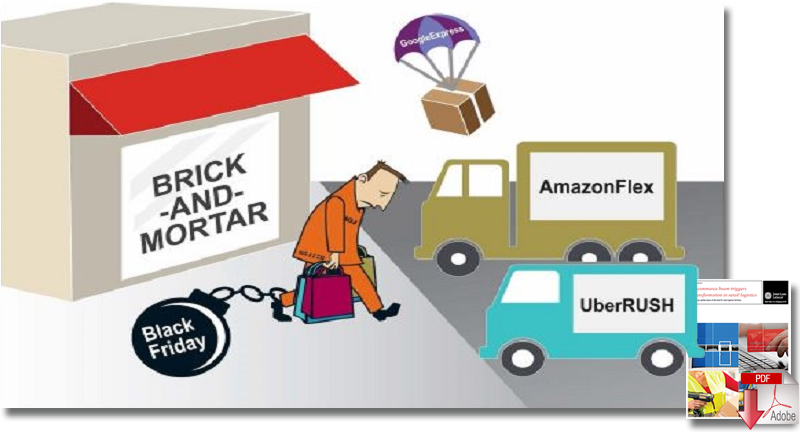Supply Chain Trends that Influence Retailers Approach to Black Friday

Black Friday may be one day a year, but the lessons learned about the limits of the current supply chains and possible creative solutions to address given limits are invaluable year-round.
With Black Friday just a few days away, it is fair to say consumers are likely getting ready to crank things up a gear for holiday shopping.
While malls are likely to be crowded as per the usual at that time of year, the advent of omnichannel shopping options for consumers provides other shopping options for those not ready or willing to deal with chaotic malls and shopping centers.
Recent research issued from global commercial real estate firm Jones Lang LaSalle (JLL) notes that as consumer shopping habits have shifted in recent years.
With many shoppers looking for alternatives to the pandemonium associated with Black Friday crowds and pre-sunrise store operating hours, retailers have taken some different approaches, including increased promotional e-mail designed to create a sense of urgency and cross-selling opportunities to shift attention and online traffic to Cyber Monday.
In its report, entitled “Grey is the new Black,” JLL takes a close look at supply chain-related trends that can influence retailers’ approaches to Black Friday,
Grey Is the New Black

In the end, the relevance of the singular ‘Black Friday’ date has been diminished in light of more of an omni-channel view to the entire holiday shopping season throughout November and December. Here are a few trends that may further shape some retailers’ approach to Black Friday.
- Variety and new alternatives in delivery options will continue to emerge and disrupt the way consumers approach their purchasing decisions on Black Friday. Services like UberRUSH, GoogleExpress and AmazonFlex all work flexible fleets of urban, street-friendly cars or vans to deliver items to consumers, sometimes without the need for intensive fleet management. Having the ability to rush orders out from either fulfillment centers or retail backrooms offer consumers speedy delivery and convenience of orders, most notably in urban and core suburban areas.
- Utilization of “dead-zone retail spaces” by retailers may continue to blur the start of storefront and supply-chains with the emergence of seasonal or mobile “pick-up” or “pop-up” locations throughout urban areas. Already being introduced through partnerships like Amazon and 7-11 in the form of pick-up locker-boxes, continued experimentation by retailers and e-tailers to alleviate the headaches and bottlenecks associated with holiday order seasonal demand.
- Attesting to the flexibility of the shared economy delivery fleets, vacant or under-utilized retail space can act as either a temporary pick-up location for online consumers hoping to avoid the large crowds associated with retail stores on Black Friday, or as micro-distribution centers where early morning, or late night-deliveries are made from larger hubs to in-fill urban locations.
- Increasingly, retailers as varied as GameStop to Staples attempt to embrace Black Friday into “Grey Thursday” as early opening hours have shifted into late night Thanksgiving door openings. Some retailers like REI are actively driving campaigns based around the notion of completely avoiding the consumer-holiday, beginnings its #OptOutside social media campaign in late October this year. The ripples of such marketing strategies have yet to be seen, however if physical stores remain closed for the holiday shoppers will be driven to a given retailer’s website to make purchases, especially if the Black Friday deal-hype can be leveraged online. Increased flexibility in the retail supply chain will be necessary to handle the additional traffic generated by such anti-Black Friday sentiment campaigns.
Supply chain strategy is often defined and reasserted on a brand’s performance following how well or poorly it handles its Black Friday. Key trends will be highlighted by Black Friday, but will also be large pieces of the ‘Last Mile’ puzzle. Black Friday may be one day a year, but the lessons learned about the limits of the current supply chains and possible creative solutions to address given limits are invaluable year-round.
Aaron Ahlburn, JLL director of research for industrial and retail property markets, said in an interview that as consumer expectations change, retailers are continuing to adapt, with JLL maintaining that Black Friday shifting from more broadly in that it is not just about one day anymore and it is more about the entire takeoff of the shopping season.
That is also playing out in terms of service levels as they relate to the supply chain, too, he explained.
“Retailers are adapting to what consumers want so if it is a matter of the last-mile delivery and getting goods to consumers as fast as possible or a matter of providing the level of service that is expected nowadays in the form of things like free shipping or quick delivery, which is what we are really looking at,” said Ahlburn. “The reality behind that is changing, too. If it is a matter of last-mile, then it is a matter of being close to the customer.”
In regards to vacant or under-utilized space being used as micro-distribution centers, Ahlburn said it has been much more prevalent in Europe than in the U.S., although it is starting to gain more traction in the U.S., due to the service and convenience factors it brings.
“It will depend on the type of retail and type of retailer having the right footprint to make that happen,” he said. “Certain retailers might be able to capitalize on that, while others may not be able to do so without the right footprint.”
When asked about what retailers need to focus on at this time of year to ensure things are running properly and smoothly as things are set to significantly ramp up, Ahlburn summer it up in one word: service.
“Every year we go through this with a new holiday season, and there are levels of service for anything about expectations for free shipping or delivery within a certain amount of time that seems to always be incrementally increasing in what people expect from they retailers they are buying from,” said Ahlburn.
Related: Last Mile E-Commerce Delivery Success Starts Early

Article Topics
JLL News & Resources
JLL Q2 report shows ongoing strong industrial real estate market trends Q1 industrial real estate activity sees continuation of strong market conditions, states JLL Q1 industrial real estate activity sees continuation of strong market conditions, reports JLL JLL research highlights the supply and demand imbalance for industrial real estate space JLL report highlights the supply and demand imbalance for industrial real estate space JLL’s industrial real estate report: Q3 trends point to record-setting 2021 Q3 industrial real estate data points to a potential record-setting 2021 More JLLLatest in Supply Chain
U.S. Manufacturing is Growing but Employment Not Keeping Pace The Two Most Important Factors in Last-Mile Delivery Most Companies Unprepared For Supply Chain Emergency Microsoft Unveils New AI Innovations For Warehouses Let’s Spend Five Minutes Talking About ... Malaysia Baltimore Bridge Collapse: Impact on Freight Navigating TIm Cook Says Apple Plans to Increase Investments in Vietnam More Supply ChainAbout the Author















